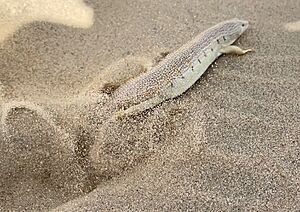Eastern skink facts for kids
Quick facts for kids Eastern skink |
|
|---|---|
 |
|
| Emerging from the sand, Al Wakrah, Qatar | |
| Conservation status | |
| Scientific classification | |
| Genus: |
Scincus
|
| Species: |
mitranus
|
The eastern skink (also called the Arabian sand skink or eastern sandfish) is a special kind of lizard. Its scientific name is Scincus mitranus. This amazing creature lives only in the deserts and dry areas of the Arabian Peninsula and parts of Western Iran.
Eastern skinks are perfectly suited for life in the sand. They can completely bury themselves, leaving only their nostrils (and sometimes part of their face) above the ground. This helps them breathe and also lets them wait for tasty invertebrates to pass by. If danger comes, they quickly "dive" into the sand. They look like they are "swimming" through the dunes as they bury themselves deeper to hide. Their scales are super smooth and shiny, which helps them dig fast and move easily through the hot sand without getting hurt. This cool behavior is why they are often called "sandfish" or "sand skink"!
Contents
What's in a Name?
The scientific name mitranus was given to this skink to honor Babu Rajendralal Mitra. He was an important archaeologist and anthropologist from India who lived from 1824 to 1891.
What Does It Look Like?
The eastern skink can grow up to 20 cm (7.9 in) long. Its back is usually orange-brown or sand-colored, helping it blend in with its desert home. Its belly is white. You might see a light line or spots along its sides, and faint dark bands on its back and legs. It has a snout shaped like a bill, and its legs and tail are quite short.
How Does It Behave?
Eastern skinks are very quick! They can run fast across the sand. If they feel threatened, they can slide into the sand and bury themselves in a flash. This is their main way to escape danger.
What Does It Eat?
The eastern skink is a hunter. It eats different kinds of arthropods. Its favorite meals include centipedes and various types of beetles.
Where Does It Live?
You can find the eastern skink in many parts of the Arabian Peninsula. This includes countries like Kuwait, Oman, Qatar, Saudi Arabia, Bahrain, and the United Arab Emirates. It also lives in Western Iran, near a city called Ahvaz. Some people think it might even live in Pakistan, but this is not fully confirmed. In Oman, it has been seen as far south as Al-Mazyunah, close to the border with Yemen. In Saudi Arabia, it has been found near Riyadh and in the deserts east of Al-Artawiyah.
Its Home in the Sand
The eastern skink loves living in places with loose sand dunes. These are sandy areas formed by the wind, which are perfect for their "swimming" and burying habits.
How Does It Have Babies?
The eastern skink is a viviparous animal. This means that instead of laying eggs, the mother gives birth to live young. This is a big advantage for them in the desert. Their babies develop inside the mother, so the eggs cannot dry out in the hot, dry sand.


